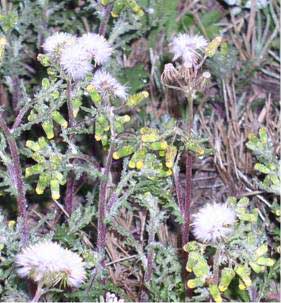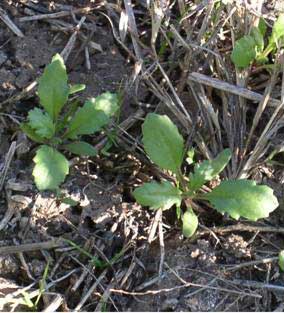Common Groundsel – An emerging Weed Problem in Low Desert Alfalfa
Barry Tickes and Eric Norton, University of Arizona
Cooperative Extension
Introduction
Common Groundsel (Senecio vulgaris) is a difficult to control and potentially poisonous weed that has become established in LaPaz County and is becoming increasingly widespread. This weed has been present in alfalfa grown at higher elevations in locations surrounding the low desert for many years but did not become established here until recently.
Common Groundsel belongs to the composite or sunflower family. This family includes about 900 species including many weeds that have been here for a long time including sowthistle, prickly lettuce, marestail, sunflower, camphorweed, cocklebur, povertyweed, dandelion, the thistles and others. This family also includes several major crops including lettuce, artichokes and flowers such as chrysanthemum, marigold and daisy. Common groundsel contains pyrrolizidine alkaloids (PA) which can be toxic to cattle and horses. PA does not seem to affect sheep and poisoning of horses and cattle is not widespread even in areas where this weed has existed for many years. Other weeds in the senecio genus, such as tansy ragwort (senecio jacoboca), are more toxic.
Although small and isolated infestations of this weed have been reported over the years, the first large scale and heavy infestation was confirmed about 6 years ago by Dan Hensley in the Butler Valley. The weed can now be found in alfalfa fields throughout the Parker Valley. No confirmed findings have been reported in Yuma County.
The seed from this weed is easily dispersed by wind, water, machinery and animals. It is flowering at the same time that sheep grazing of alfalfa fields is occurring. The proliferation of groundsel can also be correlated to the widespread use of the imadazlionone herbicides, Raptor and Pursuit, which are weak on this family of weeds.
Control
A thick healthy stand of alfalfa has always been good weed control. Most
weeds cannot compete with the frequent cutting and rapid crop regrowth.
There are times, however, when herbicides are required. A test was conducted
this season to evaluate both currently registered herbicides and potential
new herbicides for the control of common groundsel. This test was conducted
in a heavily infested second year alfalfa field along Mohave Road, North
of Agnes Wilson Road. The test contained six preemergence and five postemergence
herbicides. The preemergence treatments were applied on 10-29-03 when
the alfalfa was 1-3” in height and the postemergence treatments
were applied on 11-25-03 when the alfalfa was 4-12” in height and
the groundsel was 1 leaf to 3 inch rosette. These treatments were applied
with a backpack sprayer calibrated at 20 gallons per acre. The plot size
was 42’ by 100’ with 3 replications. Visual evaluations of
percent control were made on 1-28-04. The treatments and results were:
| Herbicide | Rate | Time | Control (%) |
|---|---|---|---|
| Eptam 7E | 4 pts. | Pre | 37 |
| Zorial 80 | 2.5 lbs. | Pre | 92 |
| Velpar 2L | 2 pts. | Pre | 97 |
| Sencor 75 DF | 0.6 lbs. | Pre | 57 |
| Visor 2EC | 2 pts. | Pre | 90 |
| Chateau WG | 4 oz. | Pre | 95 |
| Sencor 75 DF | 0.6 lbs. | Post | 90 |
| Velpar 2L | 2 pts. | Post | 98 |
| Gramoxone Max 3 EC | 2.7 pts. | Post | 87 |
| Pursuit 2 EC | 6 oz. | Post | 68 |
| Raptor 1 EC | 6 oz. | Post | 68 |
Phytoxicity in the form of leaf burning and/or stunting was noted following several of these treatments although the crop had fully recovered in all cases at the time of evaluation. The postemergence application of Sencor, Velpar and Gramoxone and the preemergence application of Velpar caused the most severe injury. Chateau, Pursuit and Raptor caused stunting but not leaf burn and no injury was evident from Eptam, Zorial or Visor. Velpar and Sencor have caused serious crop injury in many other tests but injury was moderate and temporary at this location this year.
Control with the preemergence treatments ranged from 37% with Eptam to 97% with Velpar. Eptam was sprayed on the surface and incorporated with the irrigation water within 2 days. Better deposition and control may have been achieved if it had been applied as a water run application. Velpar produced excellent control but is not likely to be registered in the low desert because of crop injury observed to non-dormant alfalfa. Velpar has been used for 20 years on dormant and semi-dormant varieties with excellent results. Chateau also produced excellent control in this test. This is a new herbicide produced by Valent that is currently used as soybeans and peanuts. Registration is being actively pursued in Arizona and California on alfalfa. Visor also produced very good to excellent control. Visor is produced by Dow AgroSciences and is currently registered on oranges and grapefruit. Dow is not currently actively pursuing a registration in alfalfa. Sencor is registered for use in alfalfa following sheeping or cutting when little crop foliage is present. Poor control was achieved with preemergence applications and excellent control resulted form postemergence applications. Crop injury is common when alfalfa foliage is present. The only currently registered herbicide that produced excellent preemergence control in this test was Zorial. No crop injury was apparent from this treatment. Zorial is registered on established alfalfa in Arizona and California. Sensitive crops cannot be planted into treated fields for 16 months following the last Zorial application.
Excellent early postemergence control was achieved with Velpar and Sencor
although both will often cause unacceptable crop injury when applied at
this time. Gramoxone produced good control when applied to very small
weeds with good coverage. Larger weeds or those receiving partial coverage
would not ordinarily be controlled. All crop foliage present at the time
of application is lost from this contact herbicide. New growth is not
affected. Buctril is another contact herbicide that was not included in
this test but is registered and has produced very good control to small
weeds under commercial conditions. Crop injury is much less severe than
with Gramoxone. Both Pursuit and Raptor were weak on this weed and should
not be used exclusively when much Groundsel is present in field to be
treated.


Issued in furtherance of Cooperative Extension work, acts of May 8 and June 30, 1914, in cooperation with the U.S. Department of Agriculture, James A. Christenson, Director Cooperative Extension, College of Agriculture and Life Sciences, The University of Arizona.
The University of Arizona is an equal opportunity, affirmative action institution. The University does not discriminate on the basis of race, color, religion, sex, national origin, age, disability, veteran status, or sexual orientation in its programs and activities.
Any products, services, or organizations that are
mentioned, shown, or indirectly implied in this web document do not imply
endorsement by The University of Arizona.
Information provided by:
Barry Tickes, btickes@ag.arizona.edu Extension Agent, Yuma County
Eric Norton, enorton@ag.arizona.edu Extension Agent, Field Crops
University of Arizona, Tucson, Arizona.
Material written February 2004.
For more Arizona Production Ag Information:
Home | Cotton | Veggies| Forages | Grains | Citrus | Crop x Crop | Insects | Diseases| Weeds | Pesticides | News | Weather | Research | Photos | Contacts | General Info. | Site Map
document located at: http://cals.arizona.edu/crops/counties/yuma/farmnotes/2004/fn0204groundsel.html
Copyright © 2001 University of Arizona,
College of Agriculture and Life Sciences
Webmaster: Al Fournier (fournier@ag.arizona.edu)